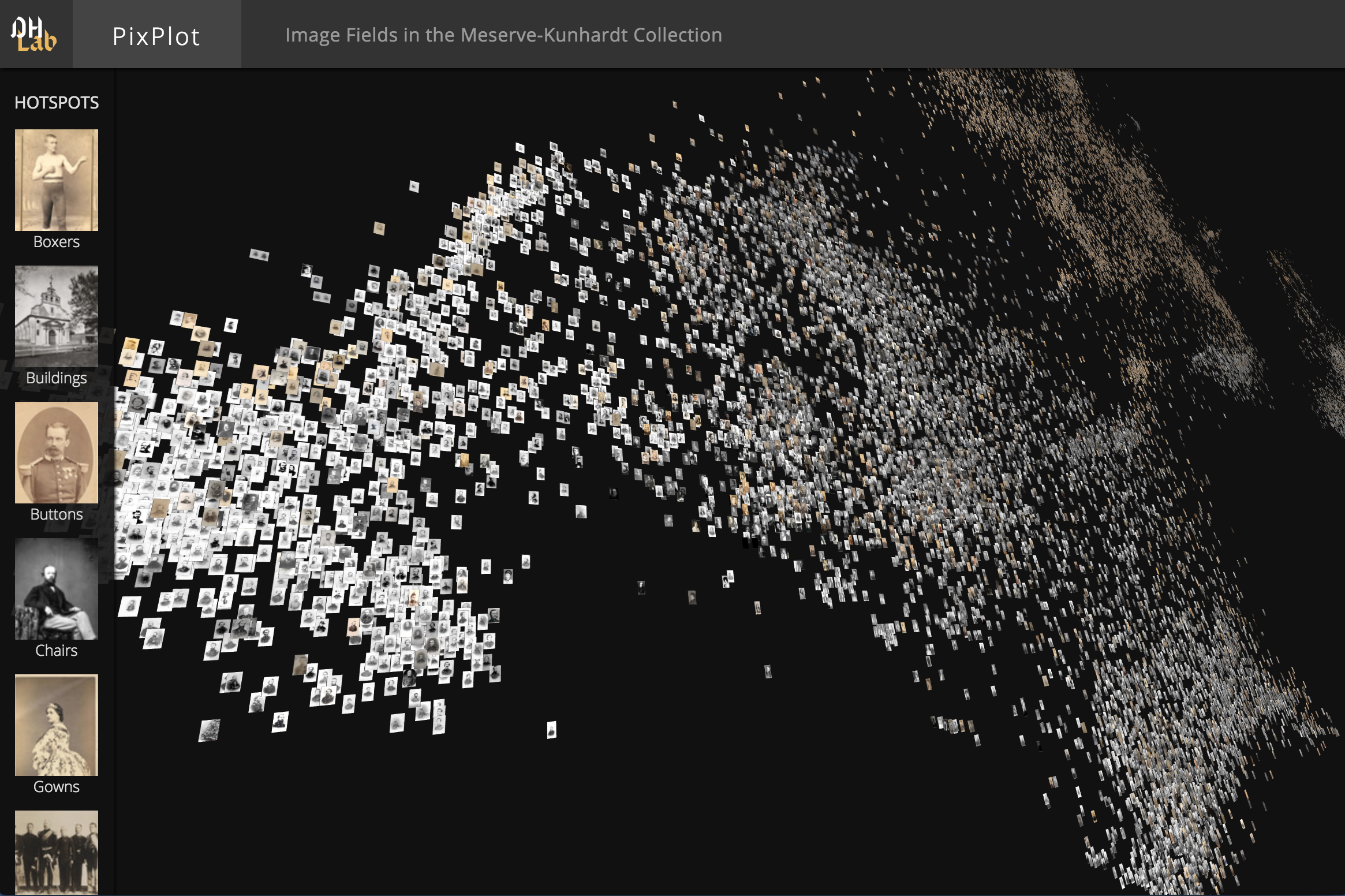YaleDHLab / Pix Plot
Programming Languages
Projects that are alternatives of or similar to Pix Plot
PixPlot
This repository contains code that can be used to visualize tens of thousands of images in a two-dimensional projection within which similar images are clustered together. The image analysis uses Tensorflow's Inception bindings, and the visualization layer uses a custom WebGL viewer.
Dependencies
To install the Python dependencies, we recommend you install Anaconda and then create a conda environment with a Python 3.7 runtime:
conda create --name=3.7 python=3.7
source activate 3.7
Then you can install the dependencies by running:
pip uninstall pixplot
pip install https://github.com/yaledhlab/pix-plot/archive/master.zip
Please note that you will need to use Python 3.6 or Python 3.7 to install and use this package. The HTML viewer also requires a WebGL-enabled browser.
Quickstart
If you have a WebGL-enabled browser and a directory full of images to process, you can prepare the data for the viewer by installing the dependencies above then running:
pixplot --images "path/to/images/*.jpg"
To see the results of this process, you can start a web server by running:
# for python 3.x
python -m http.server 5000
# for python 2.x
python -m SimpleHTTPServer 5000
The visualization will then be available at http://localhost:5000/output.
Sample Data
To acquire some sample data with which to build a plot, feel free to use some data prepared by Yale's DHLab:
pip install image_datasets
Then in a Python script:
import image_datasets
image_datasets.oslomini.download()
The .download() command will make a directory named datasets in your current working directory. That datasets directory will contain a subdirectory named 'oslomini', which contains a directory of images and another directory with a CSV file of image metadata. Using that data, we can next build a plot:
pixplot --images "datasets/oslomini/images/*" --metadata "datasets/oslomini/metadata/metadata.csv"
Creating Massive Plots
If you need to plot more than 100,000 images but don't have an expensive graphics card with which to visualize huge WebGL displays, you might want to specify a smaller "cell_size" parameter when building your plot. The "cell_size" argument controls how large each image is in the atlas files; smaller values require fewer textures to be rendered, which decreases the GPU RAM required to view a plot:
pixplot --images "path/to/images/*.jpg" --cell_size 10
Controlling UMAP Layout
The UMAP algorithm is particularly sensitive to three hyperparemeters:
--min_distance: determines the minimum distance between points in the embedding
--n_neighbors: determines the tradeoff between local and global clusters
--metric: determines the distance metric to use when positioning points
UMAP's creator, Leland McInnes, has written up a helpful overview of these hyperparameters. To specify the value for one or more of these hyperparameters when building a plot, one may use the flags above, e.g.:
pixplot --images "path/to/images/*.jpg" --n_neighbors 2
Curating Automatic Hotspots
PixPlot uses Hierarchical density-based spatial clustering of applications with noise, a refinement of the earlier DBSCAN algorithm, to find hotspots in the visualization. You may be interested in consulting this explanation of how HDBSCAN works.
Adding Metadata
If you have metadata associated with each of your images, you can pass in that metadata when running the data processing script. Doing so will allow the PixPlot viewer to display the metadata associated with an image when a user clicks on that image.
To specify the metadata for your image collection, you can add --metadata=path/to/metadata.csv to the command you use to call the processing script. For example, you might specify:
pixplot --images "path/to/images/*.jpg" --metadata "path/to/metadata.csv"
Metadata should be in a comma-separated value file, should contain one row for each input image, and should contain headers specifying the column order. Here is a sample metadata file:
| filename | category | tags | description | permalink | Year |
|---|---|---|---|---|---|
| bees.jpg | yellow | a|b|c | bees' knees | https://... | 1776 |
| cats.jpg | dangerous | b|c|d | cats' pajamas | https://... | 1972 |
The following column labels are accepted:
| Column | Description |
|---|---|
| filename | the filename of the image |
| category | a categorical label for the image |
| tags | a pipe-delimited list of categorical tags for the image |
| description | a plaintext description of the image's contents |
| permalink | a link to the image hosted on another domain |
| year | a year timestamp for the image (should be an integer) |
| label | a categorical label used for supervised UMAP projection |
| lat | the latitudinal position of the image |
| lng | the longitudinal position of the image |
IIIF Images
If you would like to process images that are hosted on a IIIF server, you can specify a newline-delimited list of IIIF image manifests as the --images argument. For example, the following could be saved as manifest.txt:
https://manifests.britishart.yale.edu/manifest/40005
https://manifests.britishart.yale.edu/manifest/40006
https://manifests.britishart.yale.edu/manifest/40007
https://manifests.britishart.yale.edu/manifest/40008
https://manifests.britishart.yale.edu/manifest/40009
One could then specify these images as input by running pixplot --images manifest.txt --n_clusters 2
Plotting Poses
In addition to the Inception-based image vectors, one can generate Mobilenet-based pose vectors for input images by installing an additional dependency:
pip install tf-pose==0.11.0
Then, when building a plot, one can pass the --extract_poses flag to the pixplot call:
pixplot --images "datasets/oslo/*.jpg" --extract_poses
Demonstrations (Developed with PixPlot 2.0 codebase)
| Link | Image Count | Collection Info | Browse Images | Download for PixPlot |
|---|---|---|---|---|
| NewsPlot: 1910-1912 | 24,026 | George Grantham Bain Collection | News in the 1910s | Images, Metadata |
| Bildefelt i Oslo | 31,097 | oslobilder | Advanced search, 1860-1924 | Images, Metadata |
Acknowledgements
The DHLab would like to thank Cyril Diagne and Nicolas Barradeau, lead developers of the spectacular Google Arts Experiments TSNE viewer, for generously sharing ideas on optimization techniques used in this viewer, and Lillianna Marie for naming this viewer PixPlot.

